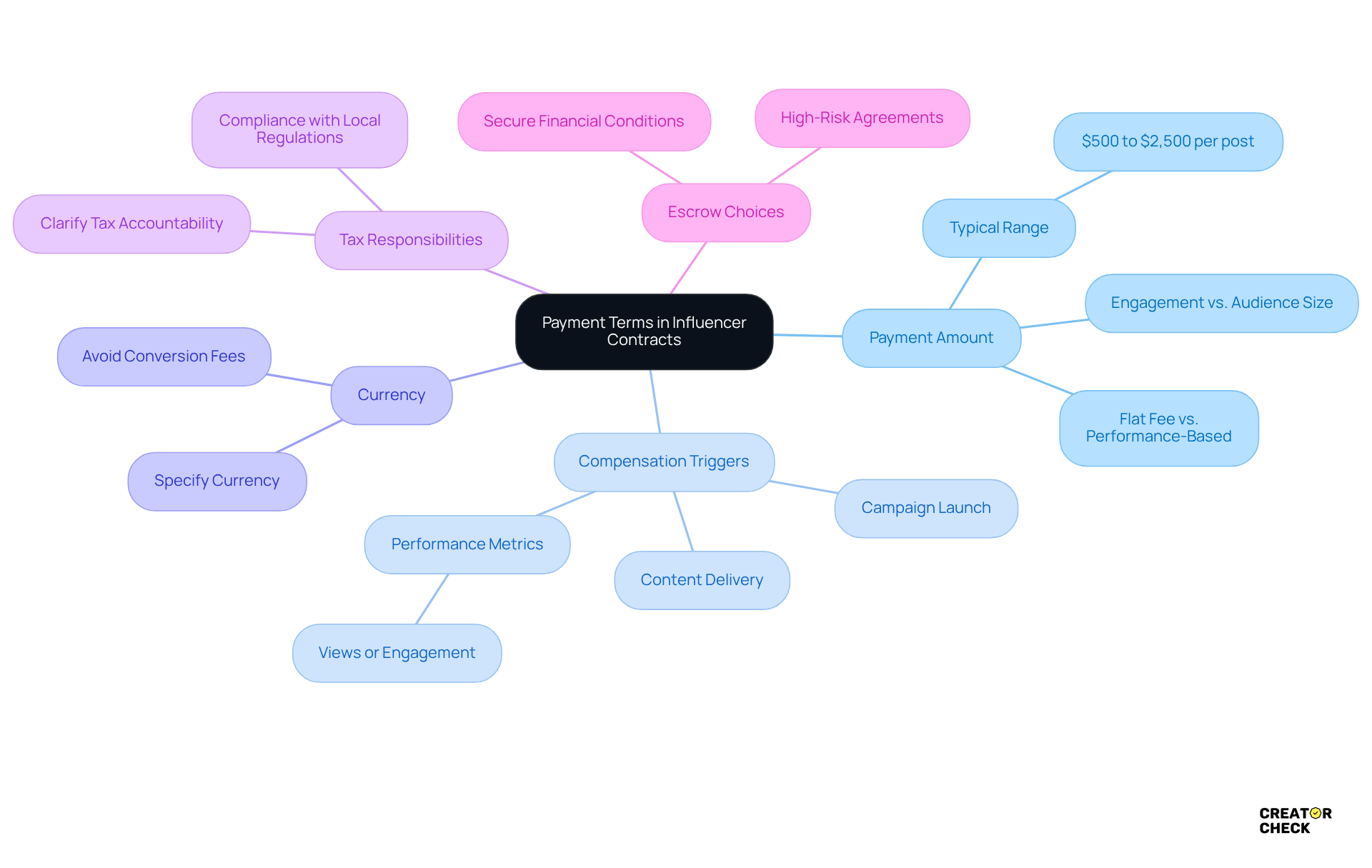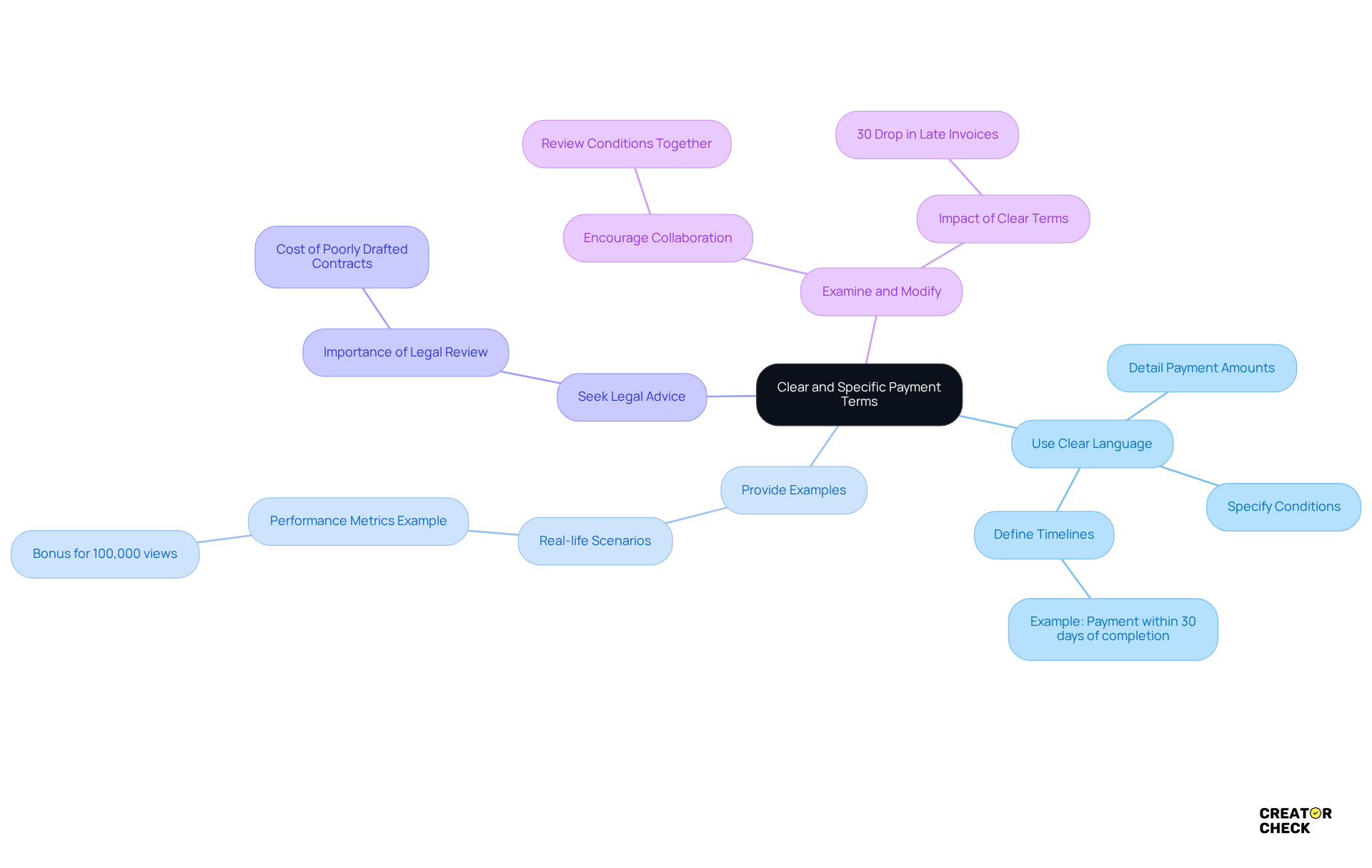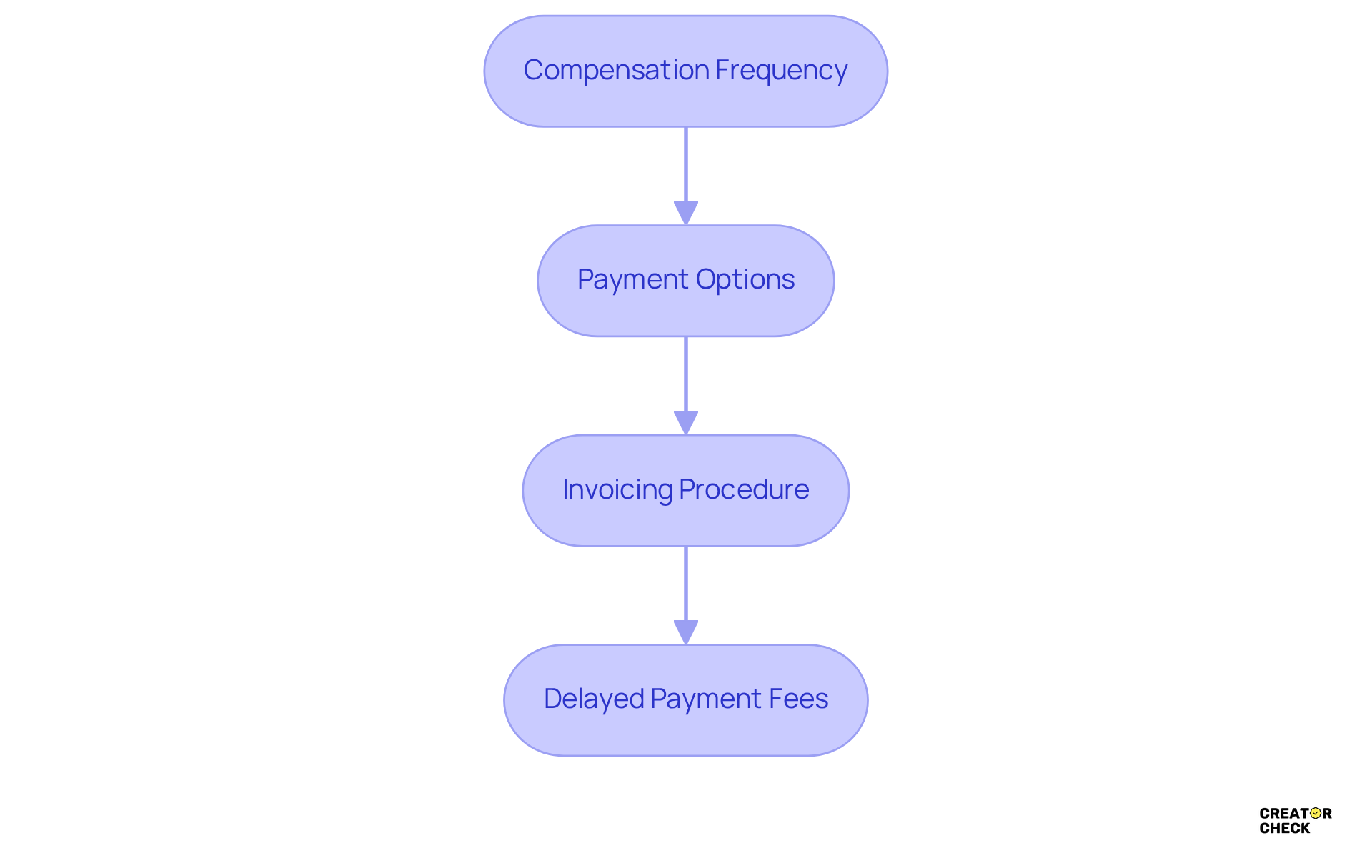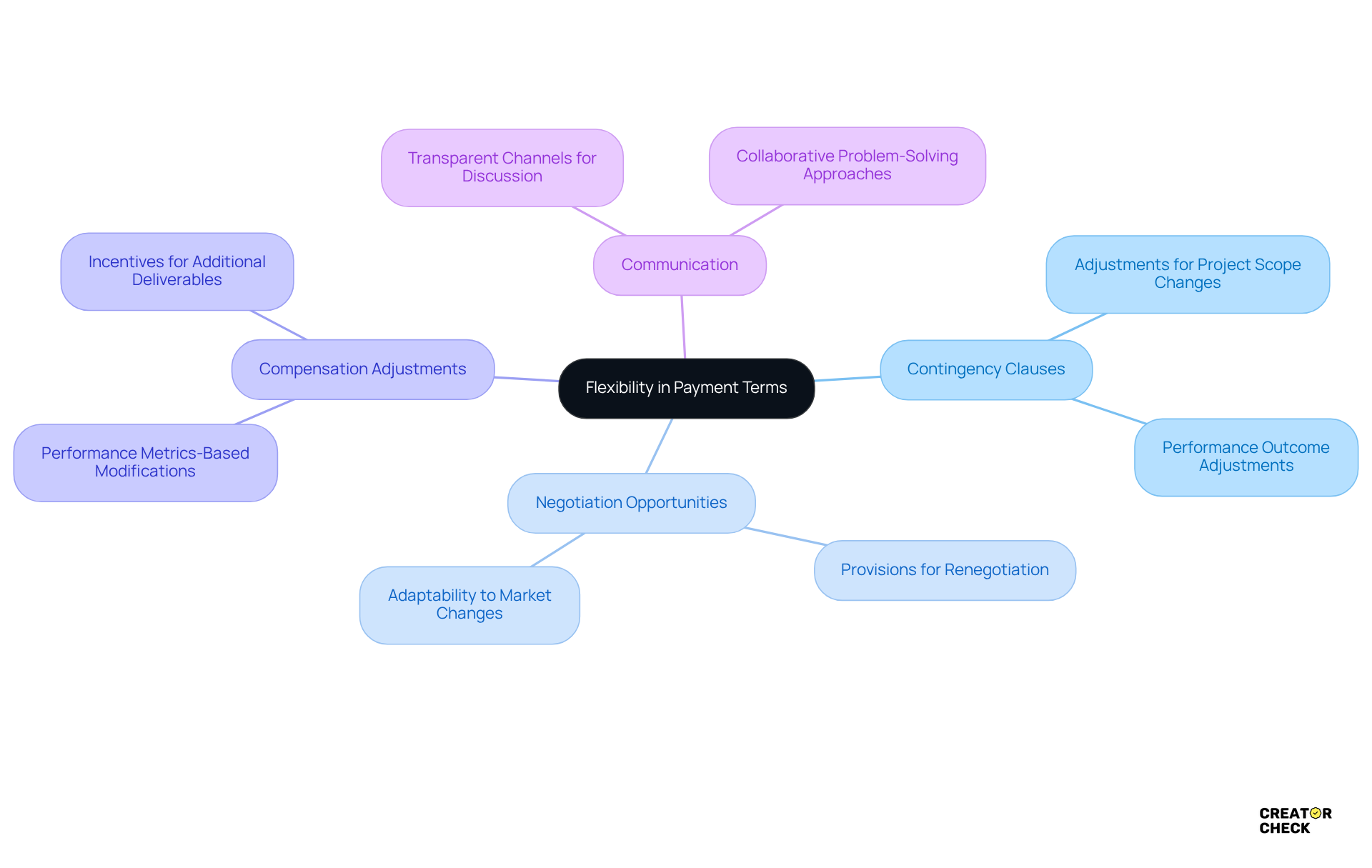Overview
This article dives into how to structure payment terms in contracts for influencer agencies. It's all about making sure everything is clear, specific, and adaptable. Why is that important? Well, having solid payment terms can really help foster transparent and professional relationships, which in turn enhances collaboration and cuts down on conflicts.
Let’s break it down: key components include:
- Payment amounts
- Compensation triggers
- Currency
- Tax responsibilities
And don’t forget about flexibility! Being able to adjust these terms as needed can make a huge difference.
So, what does this mean for you? By focusing on these elements, you can create agreements that not only protect your interests but also build trust with your influencers. It’s all about creating a win-win situation that benefits everyone involved!
Introduction
Crafting effective payment terms in influencer contracts is super important for building transparent and successful collaborations in today’s ever-changing marketing world. As influencer marketing keeps growing, agencies need to navigate the tricky waters of compensation structures, making sure both sides feel protected and understood.
So, how can agencies set up clear, flexible, and enforceable payment terms that not only meet legal standards but also help foster positive relationships with influencers? Let’s dive into the essential components of payment terms, sharing some strategies to boost clarity and adaptability, ultimately paving the way for fruitful partnerships.
Define Payment Terms in Influencer Contracts
To effectively define payment terms in influencer contracts, it’s important to outline a few key components that will make everything crystal clear:
-
Payment Amount: First off, let’s talk about the total compensation for the influencer's services. This could be a flat fee, a commission, or even a performance-based model. Just so you know, influencers typically earn between $500 to $2,500 for a single Instagram post, and this really depends on their audience size and engagement rates. Interestingly, influencers with a smaller audience but high engagement might actually command higher rates than those with a larger following but lower engagement.
-
Compensation Triggers: Next up, it’s crucial to clearly state the actions or milestones that will activate compensation. This could include things like content delivery, campaign launch, or hitting specific performance metrics. For instance, you might link transactions to fulfilling deliverables, such as submitting a video or achieving a certain number of views.
-
Currency: Don’t forget to indicate the currency in which transactions will be conducted. This helps avoid confusion, especially in international agreements. With currency values fluctuating and potential conversion fees that can cut into influencers’ margins, specifying the currency is a smart move to protect both parties from unexpected losses.
-
Tax Responsibilities: It’s also essential to clarify who’s accountable for taxes related to the transaction. This ensures compliance with local regulations and helps prevent disputes over tax liabilities. Influencers should be aware that they might need to report their earnings and pay taxes accordingly, depending on where they’re located.
-
Escrow Choices: Lastly, think about incorporating escrow choices as a checklist element in influencer briefs. This can highlight high-risk agreements for specialized management, ensuring secure financial conditions and minimizing the chances of disputes.
By addressing these components, agencies can create a solid framework for their contracts that protects both parties and fosters a professional relationship while understanding how to structure payment terms in contracts. As legal expert Stephen Taylor Heath notes, "Understanding these ten critical components is essential for protecting a party’s interests and ensuring successful collaborations." Plus, using automated transaction processing features, like those provided by Creator Check, can really streamline financial dealings and improve the effectiveness of managing financial conditions. So, what does this mean for you? It’s all about creating a smoother, more transparent partnership!

Articulate Clear and Specific Payment Terms
When it comes to discussing how to structure payment terms in contracts, it’s super important to keep things clear and specific. Understanding how to structure payment terms in contracts helps avoid any misunderstandings or conflicts down the line. Let’s dive into some key points to consider:
-
Use clear language to detail how to structure payment terms in contracts, including payment amounts, conditions, and timelines. Steer clear of vague phrases that could be misinterpreted. For instance, instead of just saying 'payment upon completion,' you could explain how to structure payment terms in contracts by saying 'payment will be made within 30 days of project completion.' This gives a realistic timeframe for agencies to think about, especially since the average collection period is around 50 days.
-
Examples: Share real-life scenarios to show how these terms will work in practice. If payment depends on certain performance metrics, make sure to define those metrics clearly. For example, 'A bonus of 10% will be awarded if the influencer reaches 100,000 views within the first week of the campaign.' This sets clear expectations and benchmarks for everyone involved, especially in understanding how to structure payment terms in contracts.
-
While clarity is key, understanding how to structure payment terms in contracts is also crucial. It’s wise to get advice from a legal expert on how to structure payment terms in contracts to ensure your terms are enforceable and compliant with regulations. As one legal expert pointed out, 'The ultimate cost of poorly drafted or generic legal documents can easily exceed the cost of hiring an attorney up front.' This is a crucial step—bad contracts can lead to expensive disputes.
-
Examine and Modify: Encourage influencers to review the conditions and share their thoughts. This collaborative vibe helps create a more satisfying agreement for both sides, particularly in understanding how to structure payment terms in contracts, thereby building trust and transparency. Studies show that understanding how to structure payment terms in contracts can significantly reduce contract conflicts, with organizations reporting a 30% drop in late invoices when these terms are clearly outlined. Plus, using digital transaction methods can make collections easier, boosting cash flow.
By focusing on these elements, influencer agencies can craft strong agreements that not only protect their interests but also nurture positive relationships with creators.

Establish Payment Schedules and Methods
To set up effective payment schedules and methods, let’s explore a few straightforward steps:
-
Compensation Frequency: Think about how often you want to disburse funds—whether it’s upfront, upon completion, or in installments. This choice should sync up with your project timeline and deliverables, so everyone knows what to expect. In 2025, many organizations are leaning towards performance-oriented frameworks, including milestone rewards tied to specific deliverables, and are exploring how to structure payment terms in contracts.
-
Payment Options: It’s important to clearly outline which transaction methods you’ll accept. This could include options like bank transfers, PayPal, or other digital platforms. Make sure to pick methods that are both convenient and secure for you and the influencer. Financial experts point out that the trend is shifting towards hybrid models that combine fixed rates with performance incentives, giving you some flexibility in compensation.
-
Invoicing Procedure: Don’t forget to outline how invoicing will work. Specify who will handle the invoices, what key information needs to be included (like project details and payment conditions), and when you expect funds to be processed. A smooth invoicing system can really boost efficiency and cut down on delays. According to industry insights, automating the invoicing process can lighten the workload and speed up transaction times.
-
Delayed Payment Fees: Consider adding terms on how to structure payment terms in contracts for overdue payments, such as fees or interest charges. This not only encourages timely transactions but also protects your organization’s financial interests, helping to build a professional relationship with influencers. As the marketing landscape evolves, companies are increasingly adopting various compensation models, with common methods including fixed rates, performance bonuses, and commission-based partnerships.
Looking ahead to 2025, the marketing industry focused on social media figures is projected to hit $33 billion. This highlights the importance of aligning your compensation methods with campaign objectives to strengthen relationships with brand representatives and ensure everyone benefits. Financial specialists emphasize that having clear agreements about compensation can really enhance collaboration and trust between organizations and influencers.

Incorporate Flexibility and Adaptability in Payment Terms
To effectively incorporate flexibility in payment terms, influencer agencies should consider a few friendly strategies:
-
Contingency Clauses: How about implementing clauses that allow for adjustments based on specific conditions? Think changes in project scope or performance outcomes. This way, both parties can adapt to unforeseen circumstances without jeopardizing the collaboration.
-
Negotiation Opportunities: What if you built in provisions for renegotiating terms if significant changes occur? For instance, shifts in market conditions or influencer availability can happen. This adaptability helps maintain a positive working relationship and ensures that everyone feels valued.
-
Compensation Adjustments: It’s important to clearly outline how amounts can be modified based on performance metrics or additional deliverables. This method can really motivate influencers to thrive in their campaigns, aligning their success with your organization’s objectives.
-
Communication: Let’s not forget about establishing a transparent communication channel for discussing any necessary changes to payment terms. Fostering a collaborative approach to problem-solving can enhance trust and lead to more successful partnerships.
By understanding how to structure payment terms in contracts and integrating these elements, agencies can create adaptable agreements that not only protect their interests but also support the influencers they work with. Ultimately, this leads to more fruitful collaborations, don’t you think?

Conclusion
Establishing clear payment terms in influencer contracts is super important for building successful collaborations between agencies and creators. By laying out specific components like payment amounts, compensation triggers, and invoicing procedures, agencies can create a framework that not only protects their interests but also builds trust with influencers. When these terms are clear and specific, it helps eliminate misunderstandings and makes transactions smoother, ensuring that everyone is on the same page.
Throughout the article, we've highlighted how crucial it is to articulate payment terms clearly and adapt them when necessary. From defining compensation structures to adding flexibility through contingency clauses, these strategies really enhance the partnership experience. Emphasizing communication and collaboration can lead to more fruitful relationships, ultimately benefiting both influencers and agencies in this fast-changing marketing landscape.
As the influencer economy keeps growing, prioritizing well-structured payment terms will be key. Agencies should not only implement these best practices but also stay open to renegotiation and adjustments as circumstances change. By doing this, they can ensure that their agreements are fair and set the stage for long-term success in the dynamic world of influencer marketing. So, what does this mean for you? It means embracing these strategies can help you thrive in this exciting space!
Frequently Asked Questions
What are the key components to define payment terms in influencer contracts?
The key components include the payment amount, compensation triggers, currency, tax responsibilities, and escrow choices.
How is the payment amount determined for influencers?
The payment amount can be a flat fee, a commission, or a performance-based model. Influencers typically earn between $500 to $2,500 for a single Instagram post, depending on their audience size and engagement rates.
What are compensation triggers in influencer contracts?
Compensation triggers are the specific actions or milestones that activate payment, such as content delivery, campaign launch, or achieving certain performance metrics.
Why is it important to specify the currency in influencer contracts?
Specifying the currency helps avoid confusion in international agreements and protects both parties from unexpected losses due to fluctuating currency values and potential conversion fees.
Who is responsible for taxes related to influencer transactions?
It is essential to clarify who is accountable for taxes in the contract to ensure compliance with local regulations and prevent disputes over tax liabilities.
What role do escrow choices play in influencer contracts?
Incorporating escrow choices can highlight high-risk agreements for specialized management, ensuring secure financial conditions and minimizing the chances of disputes.
How can automated transaction processing features benefit influencer contracts?
Automated transaction processing features, like those provided by Creator Check, can streamline financial dealings and improve the effectiveness of managing financial conditions in influencer contracts.




